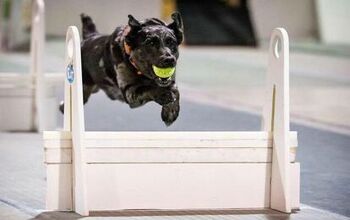Paw Myths: Safety Tips For Dog Paws

As humans, our hands are some of the most important tools we own – we use them to eat, to perform essential tasks, and to communicate. For your dog, his paws are just as important so you should make an effort to take good care of them. Unfortunately, there are a number of myths out there regarding dog paws. In this article you will learn the truth about how to keep your dog’s paws safe and healthy.
Myth 1: Your Dog’s Pads Protect Him from Winter Weather
While it is true that your dog’s paws are protected by thick padding, that doesn’t make them immune to winter weather and other winter-related conditions. The padding on dog paws contain more fatty tissue than other parts of the body which means they do not freeze as quickly, but they are still sensitive to cold and at-risk for being scraped or cut by ice. During the winter, it is common for balls of snow to collect between the toes, causing irritation and even pain for your dog. If you often take your dog outside during the winter, consider investing in some protective booties.
Related: Pawz Dog Boots Review
Myth 2: Your Dog’s Paws Protect Him from Harmful Chemicals on the Ground
Again, your dog’s paws are covered with thick padding that make them more resilient than other parts of the body. Harsh chemicals like antifreeze can, however, still be absorbed through the padding. There is also the risk that your dog might lick the chemicals off his paws – this can lead to even more severe internal damage. It is always a good idea to wipe or wash dog paws off after a winter walk to remove any chemicals he may have walked through.
Myth 3: The Size of a Puppy’s Paws Indicate his Adult Size
It is a common assumption that if a puppy has large paws, he will grow into a very large dog. While this may be true in some cases, the size of a puppy’s paws are dependent upon the breed and even if he has large paws as a puppy, he will still likely grow to a normal size for his breed. Some breeds, like Great Danes, tend to grow very quickly when they are puppies so it may seem like some parts of the body are growing faster than others.
Related: How To Trim Dog Nails
Tips for Keeping Dog Paws Healthy
Just as you provide your dog with a high-quality diet to keep his body healthy and brush his fur regularly to keep his coat healthy, there are certain things you should do to keep his paws healthy. Follow the tips below to keep your dog’s paws healthy all year round:
- Keep your dog’s nails trimmed so that they just touch the ground when he walks – they shouldn’t click or drag.
- Trim the fur between your dog’s toes to avoid painful matting.
- Use dog-friendly moisturizer to keep the padding on your dog’s paws from drying out and cracking – do not use human moisturizer because it can cause the pads to become too soft.
- Pay attention to your dog’s paws during and after walks – treat minor cuts and wounds with antibacterial wash and a light bandage.
- During the summer, avoid walking your dog on hot sand or pavement – if you must, use protective booties.
- During the winter, use protective booties or a layer of Vaseline to protect against salt and other chemicals.

Kate Barrington is the loving owner of two cats (Bagel and Munchkin) and a noisy herd of guinea pigs. Having grown up with golden retrievers, Kate has a great deal of experience with dogs but labels herself a lover of all pets. Having received a Bachelor's degree in English, Kate has combined her love for pets and her passion for writing to create her own freelance writing business, specializing in the pet niche.
More by Kate Barrington























